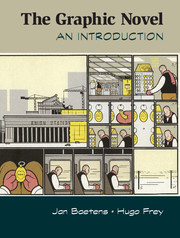Book contents
- Frontmatter
- Contents
- List of illustrations
- Acknowledgments
- 1 Introduction: The Graphic Novel, a Special Type of Comics
- Part One Historical Context
- Part Two Forms
- Part Three Themes
- 8 The Graphic Novel and Literary Fiction: Exchanges, Interplays, and Fusions
- 9 Nostalgia and the Return of History
- 10 A Short Bibliographical Guide
- Notes
- Index
8 - The Graphic Novel and Literary Fiction: Exchanges, Interplays, and Fusions
Published online by Cambridge University Press: 05 October 2014
- Frontmatter
- Contents
- List of illustrations
- Acknowledgments
- 1 Introduction: The Graphic Novel, a Special Type of Comics
- Part One Historical Context
- Part Two Forms
- Part Three Themes
- 8 The Graphic Novel and Literary Fiction: Exchanges, Interplays, and Fusions
- 9 Nostalgia and the Return of History
- 10 A Short Bibliographical Guide
- Notes
- Index
Summary
The final two chapters of this work address some important thematic ways of exploring contemporary graphic novels. In Chapter 9 we discuss the theme of nostalgia, while in this chapter we analyze the interplays between graphic novels and literary fiction that have occurred over the past decade or so.
In 2005, British novelist, writer, and journalist Iain Sinclair published a new work titled Edge of the Orison. It is an exploration of the poet John Clare’s walk from London to Northborough. Sinclair follows in Clare’s footsteps, musing on themes of memory, space, past times, and present conditions. This is what critics call psycho-geography, the sounding out of places for their forgotten historical meanings, discussing echoes of past stories woven into the everyday environment. When Sinclair reaches Northampton, extended passages of his work feature his meeting Alan Moore. For example, of Northampton, Sinclair writes: “A market square as generously proportioned, commercially sound, as a Flemish town. Such solidity of purpose demands its Bosch, its painter of demons; its Alan Moore.” Maybe one should not be surprised at the attention Sinclair pays to Moore here. In fact, their agendas and interests have criss-crossed for several years now. In particular, Alan Moore and Eddie Campbell’s From Hell overlaps with Sinclair’s own fascination with London, its dark corners, and its occult traces. In any case, after Sinclair featured him in Edge of the Orison, Moore repaid the compliment when in The League of Extraordinary Gentlemen series he invents his interpretation of Iain Sinclair, the character Andrew Norton. These quick snapshots of dialogues between literary writers and graphic novelists are far from isolated incidences, not just lone sightings in the small world of English life and letters. In America, France, and Belgium too, there has been a significant warp and weave occurring between literary fiction and the graphic novel, and vice versa. Students researching the graphic novel as part of their studies on literature courses would be missing out greatly if they did not start to piece together the many connections that have developed between the two forms. This chapter aims to assist in that venture and to point out some of the most relevant material.
- Type
- Chapter
- Information
- The Graphic NovelAn Introduction, pp. 191 - 216Publisher: Cambridge University PressPrint publication year: 2014



